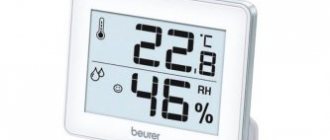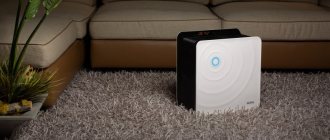Violation of the microclimate in a residential building is very often associated with an increase in humidity levels. Dampness causes the appearance of pathogenic microflora in the apartment, which leads to deterioration in the health of residents, as well as damage to their property and interior. How can you dry the air in your apartment yourself and prevent the risk of over-humidification in the future? You just need to find out the reason for moisture getting into your home, understand the methods of dealing with dampness and the types of equipment and substances used to get rid of excess humidity, and apply all this in practice.
Humidity standards in a residential area
It is believed that the normal humidity of a living space is about 40-60%. In summer and winter it will change when the heating is turned on and off. A hygrometer will help measure such indicators. To take readings in an apartment, it is better to use an electronic hygrometer.
Both dry and too humid air are dangerous for the human body. And for fans of air conditioners there is a separate reason to worry. It literally pulls water out of the air, drying it out excessively. Even damp laundry or infrequent airing can increase humidity.
Ventilation system
An additional ventilation system will help remove moisture in the basement. It is installed when air exchange is disrupted. There are two types of such ventilation:
- Natural. It uses the so-called. “vents” are openings throughout the room. According to the established norm, their area should correlate with the area of the entire room as 1:400.
- Forced. It is more often used in large rooms. It involves the installation of special equipment. It allows fresh air into the room when necessary.
Forced installation costs a lot.
Why is it worth drying out too humid air?
High humidity leads to the appearance of fungus in the house. Its spores are carried through the air, penetrating the lungs of the inhabitants and guests of the house. This causes rhinitis and asthma. If you live permanently in such unfavorable conditions, you are likely to suffer from chronic rhinitis, migraines, and disturbances in the functioning of the cardiovascular system. But there is no need to panic, in most cases you can successfully reduce the humidity.
Can dehumidification be used after winter construction?
Of course you can! Moreover, it is necessary. Even if the structure did not stand all winter waiting for construction to continue in the spring, but was actively erected despite the snow and cold, it needs to be dried. Mechanical dehumidification is best suited for this as it removes moisture from building materials. There is no natural way to dry walls, floors, and ceilings. We recommend drying even apartments in new buildings, since moisture could penetrate the concrete partitions during the construction phase and remain there after all work is completed.
Causes of dampness in the room
There are many sources of moisture in the house:
- shower, bath;
- washing clothes, drying them in the apartment;
- aquariums;
- plants;
- groundwater;
- external environment;
- people's breathing.
Among the main reasons for increased humidity are the following:
- Natural ventilation is disrupted. This is the most common reason. It is often associated with replacing windows with plastic ones. Unscrupulous manufacturers may save money and not provide the product with a special ventilation system. Such windows are too sealed and simply do not allow moisture to escape from the home. Condensation appears and mold forms.
- The foundation and walls are poorly insulated from moisture. This is due to a violation of the construction technology of a residential building. With such errors, the foundation transfers moisture to all the walls, and they evaporate it into the room. Such defects are practically irreparable.
- Oddly enough, the third most common cause is salt. It can be added to the foundation in winter to make it strong even in frost. If there is salt in concrete walls, they will be constantly wet. In this case, you need to be patient. After a few years, the walls will finally dry out.
- Frequent rains. At the same time, dampness from the street moves into the house.
- Aquariums, home fountains, waterfalls. They are best placed in rooms with a dry climate.
- Drying clothes in the rooms and kitchen.
- The windows do not face south. A shady location increases humidity.
- Weak central heating in the apartment.
- Leaking roof.
What to do with raw things?
In damp apartments, as a rule, all things in closets and chests of drawers, sofa covers and bed linen are also damp. The bed feels cold and to the touch . In addition, a characteristic unpleasant odor appears. To get rid of it, you will have to wash all things with the addition of vinegar, dry them thoroughly, and then iron them with steam. You can put linen bags with salt or silica gel in cabinets and chests of drawers. But such actions will be effective only if the causes of dampness in the home have been eliminated and the microclimate has been normalized.
Ways to reduce humidity in your home
You can reduce humidity using various means, but first it is important to identify the exact reason for its increase in your home.
- High air humidity may be temporary, for example during cooking. In this case, ventilation will help. You can use available means, for example, turn on the heater. The main thing is to ensure good circulation and oxygen access. The air flow in the room should be especially powerful if moisture begins to condense on the walls. This can be achieved using a regular draft.
- A damp room should be regularly heated with a heating device.
- Poor ceiling condition can also lead to increased dampness. It's not easy to dry it. You can try to plaster again. At the same time, the furniture is taken out so that moisture does not absorb into it.
- PVC windows can significantly limit the access of air into the home and cause dampness in it. When ordering frames, specify the presence of a special ventilation system.
- There are modern means for treating rooms that reduce humidity (for example, “Stop-moisture”). They contain absorber crystals, an absorbent. The moisture ends up in special containers.
So, you can improve humidity indicators yourself:
- Ensure sufficient sunlight penetration into the room. Open curtains regularly. There should be no bulky flowers on the windowsills.
- Ventilate more often (three times a day for half an hour). Ventilation is especially effective in summer and winter, when the air outside is as dry as possible. You can leave the kitchen window open at night.
- Ensure proper ventilation. Check whether the ventilation window is closed and whether the system itself is working.
- If it is very damp, you can turn on a household heater. It will quickly heat and dry the air.
- Drywall and wood are building materials that prevent high humidity. Use them when making repairs.
- Even walls can be covered with plasterboard. Waterproofing plaster will also help solve the problem.
- Insulate the walls outside. This will help, unless of course a flooded basement led to dampness.
- Install a hood in the kitchen. Turn it on every time you cook. Cover kitchen utensils with lids.
- Candles, a hairdryer, and even indoor plants (that don't require frequent watering) will help dry out the room's "atmosphere" a little.
- If dampness has settled in the closet, iron the clothes with a hot iron.
No. 2. Towels and bottles on the radiator
A simple folk method is to hang a damp towel on the radiator . The advice is effective, but you will have to change or re-wet the towel very often, because resourceful housewives once came up with the idea of dipping the tip of a towel/gauze/cotton fabric into a plastic bottle suspended from the radiator, in which they made a hole in the wall and poured water into it.
Another option is to simply hang a few water bottles behind the radiator . To ensure that the evaporation area is sufficient, it is better to make a hole in the wall rather than just unscrew the lid. The bottle can be decorated.
A more modern way is special humidifiers for the battery . The principle of operation is the same as that of simple bottles, but it will all look prettier. Such humidifiers are also filled with water, which then evaporates naturally; only the devices themselves are made of ceramics, steel, plastic and other materials. They can have almost any shape and color, so they will fit well into the interior, becoming its unusual decoration. Guests who are not in the know may not understand at all that this is a humidifier and not decor.
Tip – you will most likely need several bottles or humidifiers to speed up the hydration process.
Dehumidifier: operating principles
We described in detail how to dehumidify the air in an apartment without a dehumidifier, but in some cases you cannot do without this device. A dehumidifier is used if the humidity in the apartment is too high, and other methods of combating it have not helped.
- Its operation is based on the absorption of air through the evaporator. The temperature inside the device is lower than in the room. Moisture condenses on its walls and flows into the container. In this case, the dried stream flows back into the room.
- So, this device will help you quickly dry out too humid air in your apartment. The desiccant can be portable or stationary. The latter have greater productivity. They are mounted on the wall, which saves room space. Portable ones have smaller dimensions, therefore their power is lower. When purchasing, you should clarify what the power of the device is. Choose a device with maximum power.
- You can try to assemble a dehumidifier yourself. To do this, watch the video after the article.
We have described in detail how to choose a dehumidifier for your home in this article.
Ventilation
The simplest and most cost-effective option for reducing air humidity in an apartment is regular ventilation. In order for the microclimate to be optimal for the human body, first of all it is necessary to ventilate the rooms in which the moisture concentration is greatest. In a home, such rooms are the bathroom, kitchen and toilet. You can determine that there is an increased concentration of moisture in a room by looking at the windows. If they fog up a lot, then it’s time to ventilate the room. During the winter months, many people avoid ventilation because they are afraid that the cold will enter the room along with the fresh air. Experts recommend using cross-ventilation of rooms in winter, since this method is more effective than microventilation. Rapid air exchange prevents the room from cooling down.
Preventing dampness in the home
For prevention, it is worth remembering the following tips:
- After washing, showering, taking a bath, ventilate the bathroom.
- You should not dry clothes in the apartment. There is a balcony for this. Modern washing machines also have a drying function.
- Install plastic windows with ventilation.
- Avoid using an aquarium, fountain or indoor waterfall.
- Among indoor plants, choose succulents and cacti. They do not need frequent watering.
So, high humidity in apartments is a very common problem. Follow simple prevention tips and you will not encounter this extremely unpleasant phenomenon.
No. 9. More indoor plants
Everything is simple here. Plants need to be constantly watered, and some of them themselves provide good air humidification. These are ficus, hibiscus, dracaena, fatsia, nephrolepis or house fern, parmania or indoor linden, tradescantia, chlorophytum. You can place several small plants on the windowsill or a whole palm tree in the corner of the room. Both beautiful and practical.










